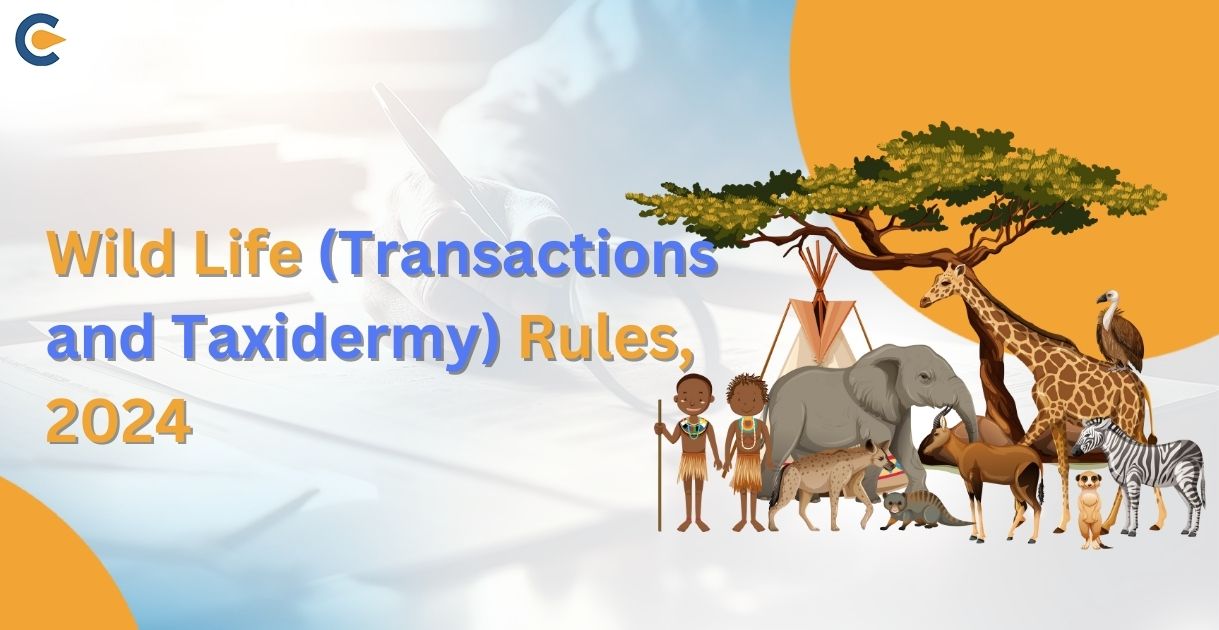The Ministry of Environment, Forest and Climate Change (MoEFC) published the Wild Life (Transactions and Taxidermy) Rules in 2024 to regulate the trade in animal species. The rules seem to amend the Wild Life (Transaction and Taxidermy) Rules, 1973, which state that a license can be granted only for trade in animals that are specified in Schedule I and Schedule II of the Wildlife Protection Act, 1973. The rules specify that the animals shall not be traded other than those permitted by the Central Government Rules. The rules seek to accord protection to animals that are most critically endangered and require utmost protection, such as tigers, elephants, rhinos, deer, stag, wolves, etc.
On the other hand, the Wild Life (Transactions and Taxidermy) Rules, 2024 stipulates that the trade in animals and species specified in Schedule II of the Wildlife Protection Act,1972 shall not require licensing by the Central Government. The new rules specify that the officer who has been authorised to grant a license to the applicant under the rules must take into consideration certain factors while granting a license, such as the animal species, financial capacity, the source of obtaining supplies and resources for performing taxidermy, the purpose for which the item has to be possessed or kept in possession etc. in form 1. Further, the authorising officer has to grant a license based on the number of existing licenses in the area and the implications of hunting, trade and transportation.
What is Taxidermy?
Scientifically, taxidermy is aprocess of preserving dead birds, animals, and other species of wildlife through internal stuffing. Taxidermy is usually done for the purpose of the scientific display or study of the animal, but it can be done for other purposes as well. Taxidermy is done by skilled experts known as taxidermists, who are skilled in making incisions, sculpting, painting, and are familiar with animal anatomy. Rare animal and bird species can be preserved using a number of unique and specialised techniques to ensure they can be studied and presented in a clearer manner. This rare species was created as a study skin by an expert taxidermist, complete with a replacement cast head, a spread wing, and a partial skeleton that included the foot, wing, and skull. These developments in taxidermy methods enable scientists to examine these significant specimens in nearly every manner possible, both now and in the future.
Exclusion of Certain Species
The Wild Life (Transactions and Taxidermy) Rules, 2024, excludes certain species from mandatory licensing requirements, notably the species names under Schedule II of the Wildlife Protection Act. Schedule II contains some important and critically endangered species, such as porcupines, macaques, whales, mongooses, etc. The absence of attention towards other scheduled species of the act raises concerns over the need to adequately address the issue of protection of endangered wildlife.
Status of Animal Trade in India
The Animal Trade in India has been a grave issue of concern for many years. Illegal poaching, trophy hunting, deforestation, and fur and hide hunting are all commercial activities that are leading to the rapid decrease in the number of wildlife species or the destruction of their natural habitat. The Government of India has taken several crucial steps in the past by entering legislation to prevent the damage done to the population and natural habitat of these wildlife species, such as the Wildlife Protection Act of 1973, Environment Protection Act of 1986, Forest Conservation Act of 1980, etc.
India is home to more than 6% of the world’s total wildlife biodiversity, with more than 7% of the world’s total mammals living here and 2.5% of the World’s total birds. Biodiversity hotspots like the Western Ghats, Nilgiris, Sundarbans, and the Himalayas house more than half of the most exotic and diverse wildlife species that are endemic to the subcontinent. Despite conservation efforts, wildlife is faced with rampant issues of illegal hunting and poaching due to invaluable commodities that have high value in the market, such as rhino horn, sake skin, elephant tusks, turtle shells, deer musk, song and exotic birds, etc. A large part of these activities are part of the global wildlife trade, which is a multi-billion dollar industry. India is a major hub of wildlife trade and trafficking. Air and Sea trafficking is also a grave concern since it links domestic trade with international markets. The airports and ports of Mumbai, Chennai, and Mangalore are important hubs for the widespread trafficking of reptiles, particularly turtles and tortoises, into and out of India. The most trafficked reptile in the world, the Indian star tortoise, is shipped to Thailand, Singapore, and Malaysia from trade hubs in Karnataka, Andhra Pradesh, Gujarat, and Tamil Nadu.
Wild Life (Protection) Amendment Bill, 2022
Since India is a signatory to the Convention on International Trade on Endangered Species of Wildlife, Fauna and Flora (CITES), the Wild Life (Protection) Amendment Bil,2022 helps the country achieve its commitment towards wildlife conservation and covenants in CITES. The Bills seek to enhance the conservatory framework for wildlife by increasing fines and penalties for illegal hunting and poaching of animals. The bill seeks to cordon off protected areas completely from human intervention, except for certain permitted activities such as grazing of livestock, collection of timber, or drinking water for household use. This would minimise human interaction with animals in their natural habitat and provide the necessary isolation and protection from illegal encroachment and hunting activities. Also, the legislation extends the protection of the forest land to the exclusive use of the forest dwellers since they have to face expulsion or relocation due to the destruction of their natural habitat.
The Bill introduced the constitution of a standing committee which is authorised by the State Wildlife Board to exercise powers over the wildlife sanctuaries and bird/animal reserves in the state. The Committee can recommend that the Chief wildlife warden control the management of all the Sanctuaries in the state.
Section 43 of the amended act permits the use of elephants for religious and any other uses. Further, the bill also empowers the Central Government to take adequate steps to stop the trade, possession, and advancement of invasive or alien species.
Under the Bill, the penalties for violation of the provision of wildlife protection have been enhanced to ensure better enforcement. The penalty for general violation entails a penalty from Rs. 25,000 to 1 lakh. In the case of specially protected species, the minimum fine has been increased from 10,000 to 25,000.
Conclusion
Wild Life (Transactions and Taxidermy) Rules, 2024, has been enacted to promote ethical taxidermy practices and the display of the mortal remains of dead animals and birds. The Rules specify the manner in which the animal remains can be acquired, possessed, and traded. However, the rules have increased regulatory oversight by making compulsory licensing and prior approval from the government necessary for trade in animals specified in Schedule I of the Wildlife Protection Act,1973. The rules mention the manner of obtaining a license or permit for a taxidermist from the concerned government. The Transactions and Taxidermy Rules are, indeed, a very important step in the relatively unknown domain of wildlife conservation in India.
Frequently Asked Questions (FAQs)
What is Taxidermy?
Taxidermy is a process of preserving dead birds, animals, and other species of wildlife through internal stuffing and embalming. Taxidermy is usually done for the purpose of the scientific display or study of the animal, but it can be done for other purposes as well. Taxidermy is done by skilled experts known as taxidermists, who are skilled in making incisions, sculpting, painting, and are familiar with animal anatomy.
Taxidermy of what species are excluded from licensing under the Wild Life (Transactions and Taxidermy) Rules, 2024?
Transactions and Taxidermy Rules exclude certain species from mandatory licensing requirements, notably the species names under Schedule II of the Wildlife Protection Act,1973.
What is the condition of animal trade in India?
The animal trade in India has been a grave issue of concern for many years. Illegal poaching, trophy hunting, deforestation, and fur and hide hunting are all commercial activities that are leading to the rapid decrease in the number of wildlife species or the destruction of their natural habitat.
What is the purpose of the latest rules of wildlife?
The purpose of Wild Life (Transactions and Taxidermy) Rules, 2024, is to regulate the trade and taxidermy ofanimal species. The rules seem to amend theWild Life (Transaction and Taxidermy) Rules, 1973, which state that a license can be granted only for trade in animals that are specified in Schedule I and Schedule II of the Wildlife Protection Act, 1973.
Who is the nodal authority authorised under the act?
The government has authorised the Chief Wildlife Warden as the nodal authority for the purpose of granting a license and inspecting the licensee under the Transactions and Taxidermy Rules.
What are the different species that are mentioned in Schedule II of the Act?
The wildlife species that are mentioned in the act are porcupines, macaques, whales, mongooses, langurs, monkeys, etc.
How can a person make an appeal against an Order of the Chief Wildlife Warden?
Any person aggrieved by the order of the Chief Wildlife Warden can make an appeal before the State Government after 15 days of receiving the order.
Read Our Article: Importance Of Environmental Due Diligence











